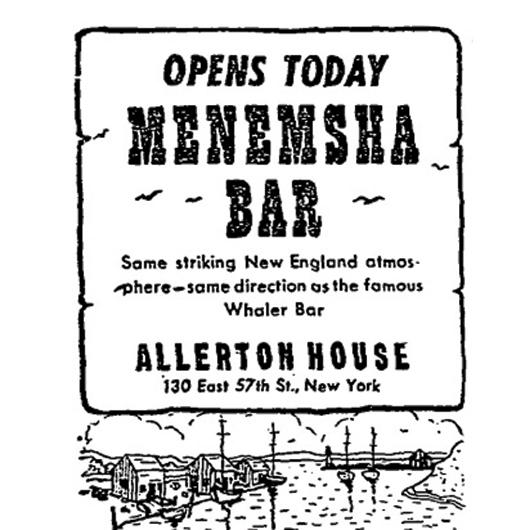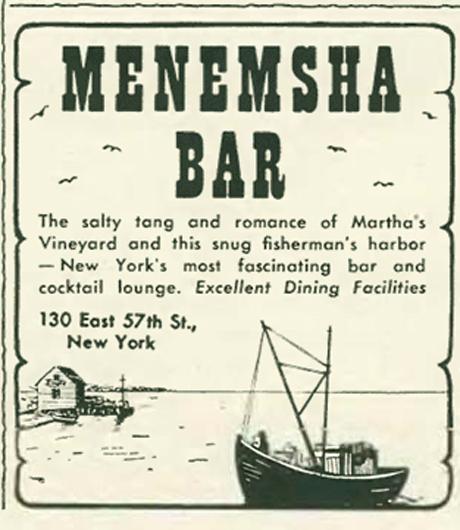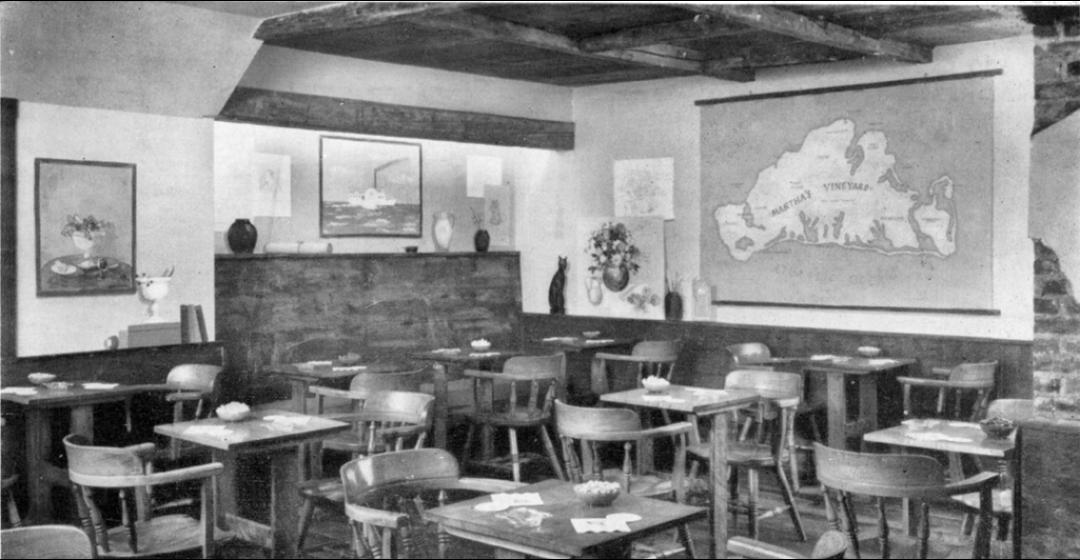“Oh, the Menemsha Bar! I might need to pour a martini! That’s all we ever drank there!” rhapsodized Jane Slater. It was a warm, late-summer day and she leaned back, smiling in her chair behind the counter of Oversouth Antiques in the village of Menemsha proper. Her memories carried her back to Manhattan more than fifty years ago, and the thought of the old bar put her in a reverie.
“It was the neatest little place – a real cocktail lounge of the old school. A small bar, a lot of little tables, very low lights,” she said. The Menemsha Bar lay below street level in the Allerton Hotel, a New York City hotel for women located at the corner of Lexington Avenue and East 57th Street. What made it famous was a diorama that lay along one wall offering a fanciful panorama of the old fishing port.
“They had a picture of the jetty and – I don’t know – there was probably a boat,” said Slater. When a patron asked, the barkeep pushed a button. In the diorama, the clouds darkened and advanced over the hamlet. “And then all of a sudden the thunder rolls! And there’s lightning! And then there’s rain – real rain comes pouring down! And we all sit there: ‘Oh-h-h!’ And then it clears,” she said, grinning with wonder. The sun came out, a gull cried, droplets rolled down the inside of the glass, and at their table, she and her friends would relax and agree: “It’s time for another martini!”
The Menemsha Bar opened in New York City on October 17, 1947, the brainchild of two Vineyard seasonal residents. One was Burton Friend White Jr., a vice president of the Allerton Corporation in New York, who had summer homes at Cedar Tree Neck and in Edgartown. Likely sharing in the process was fellow Allerton board member Chester Tipton, of Manhattan and Edgartown. The impetus for the bar, however, probably goes back to the establishment of a rival residential hotel for women, the Barbizon, a few blocks uptown on Lexington.

The Allerton was built first. Based in Chicago, the parent company realized in the years following World War I that young single women moving into the professional ranks were arriving in the big cities in need of places to live where they would feel comfortable and safe. The Allerton, one of six established by the company in Manhattan, would have “a high standard of admission,” said The New York Times, and “each guest once admitted will be her own mistress.” Amenities included a sewing room, ballroom, “strictly up to the minute laundry,” and lounges on three floors “to which, of course, men will not be admitted.”
The Allerton opened in 1923, followed by the Barbizon just up the avenue in 1927. What the Barbizon figured out first, however, was that this women-only business need only go so far, and that a merry little tavern on the ground floor of a building full of single women might attract a profitable supply of patrons, both male and female. It opened the Whaler Bar, which offered portholes in the port and starboard walls, behind which were moving paintings of the ocean and horizon that were synchronized to slowly go up and down in opposition. “After a few beers you began to think the horizon...was fixed and the floor was rolling like the deck of a ship,” wrote Ralph Eugene Crump in It’s an Ill Wind: Memories of a Young Man (Authorhouse, 2007).
The Allerton would do better than that – much better. On one wall, for context, hung a large map of the Vineyard. Along another hung a painting of an Island side-wheeler. Down the length of a third wall lay the diorama, looking seaward, which you could ask the bartender to drench with a minute-long cloudburst as often as you wished. Vineyarders, whether year round or seasonal, swarmed the place whenever they went into the city. Often year-rounders and summer people – who mixed socially more than they do now, longtime Menemsha residents agree – went together.
“There was a bunch of us that palled around in the summertime,” said Everett Poole of the Chilmark Chandlery in Menemsha. The friends were young, ranging from their teens to mid-twenties. “And we decided to have a reunion, and we had it in New York.” It was the winter of 1951. “And I took a car from here and had, I think, it was at least five people in it. There was my cousin Matt [Poole] and Harriet [Otteson]. And [Elmore] ‘Buddy’ Mayhew. And myself. I’m not sure that there was anybody else from here. And then there was some came from Pennsylvania, and some came from New York, and some came from Connecticut, and we all gathered there.”
They toured the city, visiting the Empire State Building, Statue of Liberty, and the Automat, said Otteson. They saw Katharine Cornell star in The Constant Wife, a hit on Broadway, and because Cornell was a seasonal resident whom everyone on the Island knew, the young Vineyarders were invited backstage and gave her roses. The whole adventure began with a reunion at the Menemsha Bar, where the meteorological melodrama, assailing a village they all knew and loved, absorbed the attention of all – but didn’t keep them from letting the little seaport have it over and over again. “We made the guy play the thing three or four times until he finally threw us out,” said Poole.

Ward Just, the author from Vineyard Haven, was writing for Newsweek in the mid-1960s; the bar was right across the street. He remembered the décor being a bit more elegant than the way the up-Islanders described it in the early 1950s. “By more elegant, I mean I remember the chairs as sort of leather covered.” The tables were wooden and heavy, the atmosphere a mix of seaside tavern and English pub, he said. “It was a little more elaborate then.”
Kib Bramhall, the West Tisbury artist, said he probably first visited the bar in the 1950s, when he was a student at the Hotchkiss School in Connecticut. He kept stopping by through his years at Princeton University and didn’t recall many changes. But he thought his late brother David, who lived in New York City, might have sensed the clientele beginning to change. Everett Poole said flatly that last he heard, it was a gay bar.
Precisely when the Menemsha Bar closed remains a mystery. Another version of the old Whaler Bar still exists at what today is the Jolly Madison Hotel at East 38th Street and Madison Avenue. But the Menemsha Bar itself was long gone by the time the Allerton finally closed as a single-room-occupancy hotel in the early 2000s. Now it’s the Renaissance New York Hotel 57.
Yet somewhere down in its basement, the square footage that once made up the Menemsha Bar still exists. Perhaps the wall where the diorama lay does too. But when you explore the lobby, you notice the elevators only go up to where the women once lived, and if there’s a thunderstorm still going on down there, no one at street level would ever know.




 11 comments
11 comments
Comments (11)